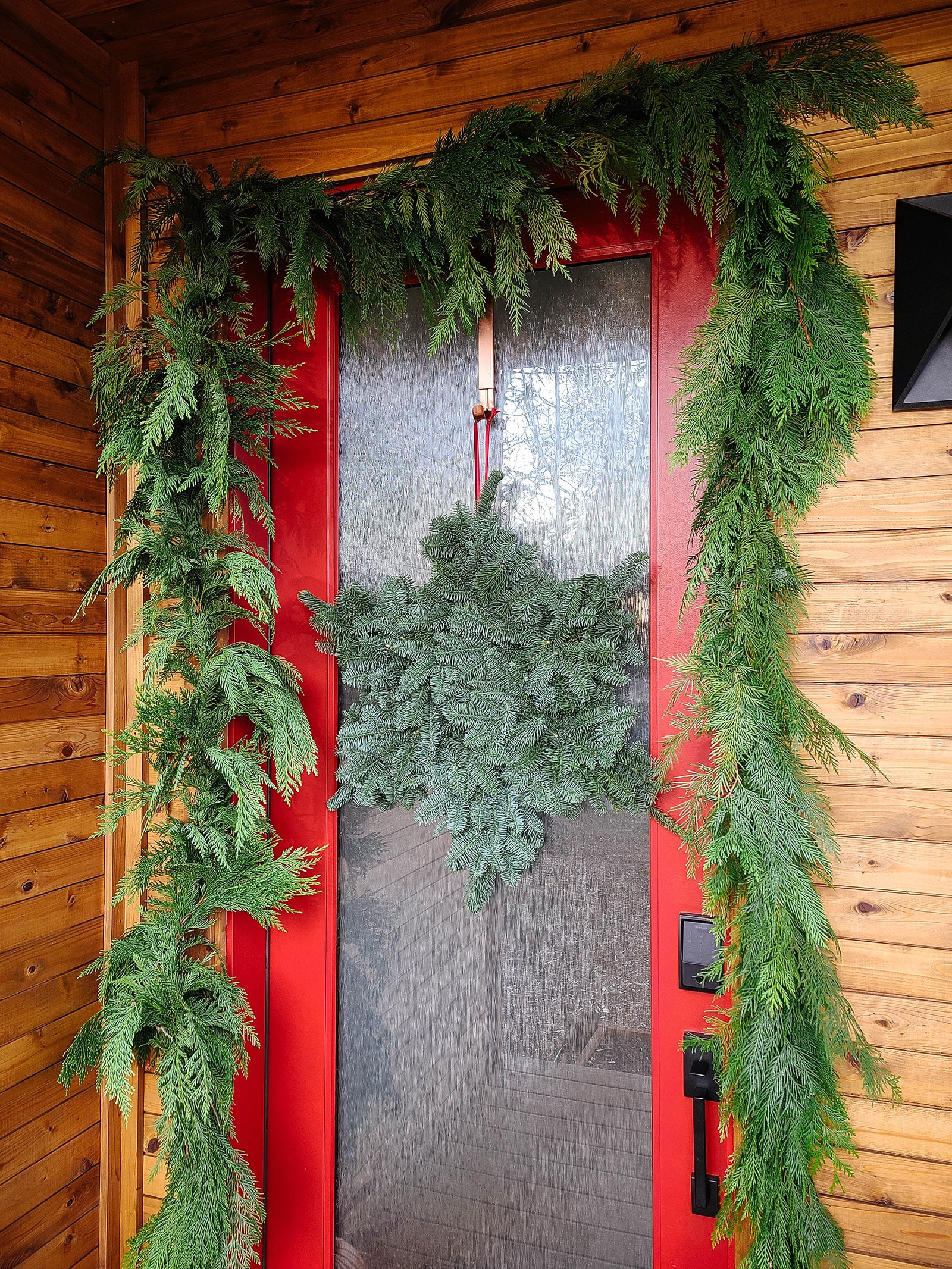I love the holidays but I really just celebrate Christmas (the commercial holiday) for my kids. For myself, I celebrate winter with a simmer pot of citrus and spices on the wood stove, mulled wine, bottomless stews, alllll the lights, and alllll the greenery. The more, the merrier!
Evergreen wreaths, garlands, swags, and centerpieces are harbingers of the most wonderful time of year, and few things feel more festive than your home smelling like a forest. (It’s like forest bathing, but you don’t even have to leave your house.) When it comes to holiday greenery, nothing really compares to the real thing—but like all living things, keeping your wreath fresh and vibrant can be tricky.
Many wreaths turn brown prematurely because they dry out prematurely—but you can slow the process and keep your wreath green long past the holidays. My own wreaths and garlands stay fresh for about eight weeks with no needle drop!
This is what I do every year to help my wreaths keep going after the New Year:
Buy the freshest wreath available
To ensure your wreath doesn’t turn brown too quickly, you have to start with the freshest wreath you can find. If it feels fairly light, the needles look pale, and the wreath seems dry, chances are, it’s already a few weeks old and won’t last much longer in your home.
Give it a good shake. If the wreath or garland sheds a lot of needles, take a pass because you likely won’t be able to bring it back to life.
Give it a sniff. Does it smell like you’re walking through a forest? Wreaths made of pines, firs, cedars, or spruces should all smell like a freshly-cut Christmas tree.
Soak your greenery in water overnight
Most people skip this step, and it’s one of the most important! As soon as you bring your greenery home, soak it in water overnight (or at least for a few hours). Ideally, all of the needles should be submerged so they can rehydrate. If there’s a rainstorm passing through, you can also leave your wreaths outside and let them drink it up.

Just don’t soak them in your nice white bathtub—live evergreens with sap can sometimes stain. Instead, fill a large bin or an old kiddie pool, or use your rain barrels if you want to conserve water.
I soak my wreaths and garlands in the utility sink in our garage because, well, that’s the kind of messy job it’s meant for! I pile them all into the sink, spray them down, fill the tub, and leave them submerged for at least 8 hours. (This also helps to remove any tiny pests that may have hitchhiked on the stems.)


If you have an evergreen centerpiece, treat it like a houseplant and give it a shower in the sink. Mine are usually arranged in floral foam, so I fill the vessel with water for the foam to absorb.

Once your wreaths and garlands have soaked overnight, move them onto towels (or in my case, an old moving blanket) and let them drip dry before you decorate.

Protect your wreaths and garlands from the elements
If you haven’t decided where to hang your wreaths and garlands, the best place to put them is outdoors, away from direct sunlight and high winds. They much prefer the cooler air outside (versus a heated home with warm, dry air) and will last the longest if they’re hung under a covered porch.

But if you have your heart set on bringing your greenery indoors, hang them out of direct sun and away from fireplaces, heating vents, or radiators. They won’t dry out as fast if kept in the coolest part of your house, and at night, it’s best to dial down the thermostat (which will help your Christmas tree last longer too).
A fresh wreath can stay lush and green for up to eight weeks outside, but it might only make it a couple of weeks if it’s placed in full sun or inside a very warm home.
Water your wreath regularly
Evergreen needles are able to absorb moisture through microscopic openings called stomata—pores, essentially. Since they’re still living plants, wreaths and garlands need regular water to retain their needles and stay green. Watering also helps bring out their woodsy fragrance again!
There are a few ways you can do this:
- If your wreath isn’t adorned with lights and ornaments, you can soak it in a tub once a week for a few hours to hydrate it.
- For a decorated wreath or garland, fill a spray bottle and spritz it every few days with water—particularly the back where the cut ends of the boughs are. In very dry homes, it may also help to mist your greenery a couple times a day to stave off browning.
- Centerpieces should be watered regularly like houseplants. Be sure to refill the vessel when the water is getting low, and put it in the sink once a week to spray it down and remove any dust.
Follow all these tips and your holiday wreaths and garlands should make it through January before they start to dry out!
















I remember being a kid helping my mother pruning branches of yew for wreaths. This yew (Taxus) species sprawls along damp forest floor, tolerating shade and requiring damp soil. As an adult homesteading in Western Massachusetts, our woodlot had one specimen of this yew. I harvested enough boughs annually to make one generous wreath. It was on our external door from about mid November through most of February. The needles were a bit dry and crunchy by then but few if any dropped. Still, if I had Linda’s advice then, I would have taken it. I think that a lot of wreaths and sprays nowadays constructed with byproducts of Christmas tree harvest. In that case, Linda’s advice is essential. It just didn’t occur to me to make wreathes with material from lower branches left when a Christmas was cut. That represented a missed economic opportunity, of course.